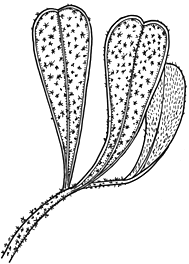Hibbertia hermanniifolia DC. APNI* 
Description: Spreading shrubs 0.8–1.5(–3) m high. Young stems densely tomentose with erect to spreading stalked radial fascicled hairs; intrapetiolar tufts absent.
Leaves subsessile or indistinctly petiolate, obovate to oblanceolate, 3–30 × 1.8–10 mm, discolourous; margins entire, slightly recurved; adaxial surface flat to ± folded or grooved along midrib, sparsely to moderately pubescent to velutinous with erect simple and antrorse fascicled hairs, ± glabrescent; abaxial surface densely tomentose with spreading stalked radial fascicled hairs, midrib narrow, rarely raised above recurved margins; apex truncate to emarginate or rounded, sometimes with a recurved excurrent midrib.
Flowers solitary, terminal on short lateral branches, pedicellate; pedicels (3–)4–12(–18) mm, indumentum as for young stems. Bract 1, spathulate to linear-oblanceolate, 3.3–5.5 mm, indumentum as for leaves. Sepals 5.1–7.4 mm, outer linear-lanceolate to lanceolate, ridged, acute; inner ovate, not ridged, acute to obtuse; abaxially tomentose to hirsute with fascicled hairs and marginal cilia; adaxially glabrous or sparsely puberulous towards apex. Petals 5, yellow, oblong-oblanceolate to obovate, 6.5–9.5 mm, shallowly emarginate to entire. Stamens 9–24, surrounding carpels, 1(–3) longer than others; filaments ± free, 1.1–1.5 mm; anthers narrowly obloid, 1.2–2.1 mm, latrorse; staminodes few, filiform. Carpels 2, obovoid, hirsute; styles excentric, spreading then erect, 2.5–3.5 mm. Ovules 2–4 per carpel.
Seeds glossy black, obovoid to almost spherical, 2.5–2.9 mm; aril with fleshy base and 3–4-lobed cup-like membrane clasping seed base.
Flowering: August to February.
Distribution and occurrence: Widespread from north-eastern to south-eastern New South Wales and into north-eastern and eastern Victoria. Occurs in shrubland and sclerophyll forest, typically on dry slopes or rocky outcrops with skeletal soils over granite or sandstone.
NSW subdivisions: NC, CC, SC, NT
Other Australian states: Vic.
Hibbertia hermanniifolia belongs to the H. hermanniifolia species group within subgen. Hibbertia. Memebers of this group have stamens arranged around two hairy carpels, often with one or more inner stamens longer than the rest, and ± flat leaves with an exposed, densely fascicled-hairy abaxial surface. This species is distinguished within the group by its conspicuous, often dark-stalked fascicled hairs on the underside of the leaves. It is most similar to H. acaulothrix Toelken, which lacks stalked hairs and differs further by having shorter pedicels (to 18 mm) and a bract shorter than the calyx. Two subspecies are recognised: Hibbertia hermanniifolia subsp. hermanniifolia and Hibbertia hermanniifolia subsp. recondita
Text by Timothy A. Hammer, Kevin R. Thiele. Hibbertia hermanniifolia subsp. hermanniifolia, in P.G. Kodela (ed.), Flora of Australia. Modified by A.E. Orme
Taxon concept: H.R. (2012). Notes on Hibbertia (Dilleniaceae) 7. H. hermanniifolia group (subgen. Hemistemma) from mainly temperate eastern Australia. Journal of the Adelaide Botanic Gardens 25: 55–70.
APNI* Provides a link to the Australian Plant Name Index (hosted by the Australian National Botanic Gardens) for comprehensive bibliographic data
***The AVH map option provides a detailed interactive Australia wide distribution map drawn from collections held by all major Australian herbaria participating in the Australian Virtual Herbarium project.
|


